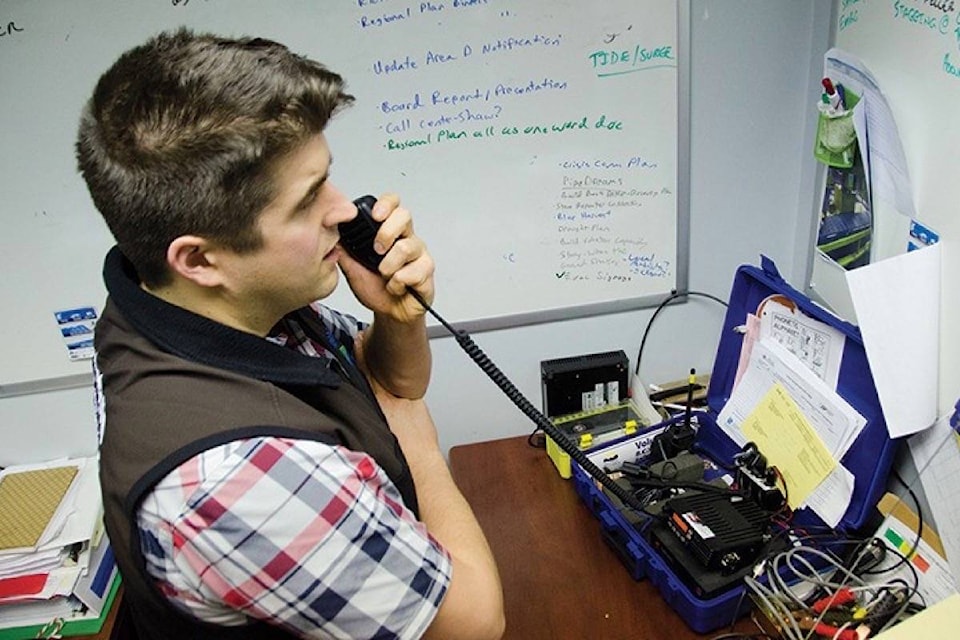Amateur radio operators helping with emergency communication all over the Island are now better equipped to do so – and will soon also have additional infrastructure in place to also make the best use of it.
Shaun Koopman, protective services coordinator for the Strathcona Regional District, says the installation of a “digital node” up on Mount Washington will add a huge amount of capacity and integration within the communications system should there be an emergency in our region.
Paul Peters, chair of the Mid-Island Emergency Radio Coordination Team, which has been overseeing the implementation of this and other communications initiatives, agrees with Koopman, saying the key to amateur radio operators being able to best be of help in an emergency response situation is two-fold: interoperability and standardization.
Interoperability, according to Peters, “is the notion of building a pre-plan that allows you to create survivability for any community or environment well in advance of an activity.”
When it comes to radio communications, that basically means “all responding agencies being on a common frequency or a group of common frequencies,” Peters says.
So about a year ago, the Multi-jurisdictional Radio Interoperability Project (MRIP) was launched to create a “code plug” of radio frequencies that can be used by amateur radio operators on Vancouver Island. It contains “about 170 voice frequencies and 14 digital frequencies. It was a herculean task and a couple of full days of keystokes by dedicated volunteers,” Peters says, but it is now ready to be loaded onto radios all over the Island.
In terms of standardization, Peters says, what’s important is not only to have all of the radios loaded with this “code plug,” but also have everyone trained to the same standard.
After all, Peters says, the reason amateur radio plays such a key role in supporing every emergency operations centre, particularly here on Vancouver Island, is because they are “insourced.”
“They work directly with the local authorities. Shawn (Koopman) has amateur radio people who work directly with him. He works with a team and trains with a team and they are embedded in the system and who will work together in supporting the SRD and local environs in the event of a major emergency.”
In other areas of Canada, Peters says, most areas use “outsourced” amateur radio operators in supporting communications during emergencies.
Those could be local amateur radio clubs, or just a selection of people who have said they will help should they be needed, “and as such they maybe aren’t trained to the same level that, as an example, Shawn would want all responders populating an EOC (Emergency Operations Centre) to have.”
If everyone is trained to the same level and is working with the same equipment, Peters says, the system works much more efficiently.
So now, equipped with an MRIP package, a radio operator team from Campbell River or any other jurisdiction, can go anywhere on Vancouver Island and have access to every frequency they will need wherever they go, Peters says, “and they can go in fully ready to provide service. They may not have ever even been there before, but they can show up with a radio and be immediately valuable.”
So what about this “digital node” on Mount Washington?
Well, when direct-line, “Peer-2-Peer,” communication isn’t an option, there needs to be another way to get signals through. A radio signal can’t travel through the rock of Quadra Island to get over to Cortes, for example.
“In a situation like that, you may have to rely on a high-level location to re-transmit that particular signal to a distant location,” Peters says.
And so, sometime this spring, a digital node will be placed up on Mount Washington to re-transmit signals much further afield.
“Mount Washington’s footprint from a radio perspective spans north to Sayward, south all the way into Surrey, and is well heard in Parksville/Qualicum and over in Powell River,” Peters says.
There will be another node located on Mount Pocahontas on Texada Island. That node, having internet connectivity, can then transfer digital information anywhere in the world.
The value of having these high level nodes in place, standardized radios programmed with the proper frequencies, along with operators who are trained to the same levels of proficiency makes the system much more efficient, Peters says.
But there still need to be operators in place, and while Koopman has a small, dedicated team, he’s still looking to get more people trained up. As such, he’s running another round of training sessions starting at the end of the month.
For more information on the upcoming courses, contact instructor Frank Wallace at 250-285-2297 or by email at wallace@pacificcoast.net. Courses will be available in both Campbell River and on Quadra Island.
There is a $50 fee for the course, but Koopman says he won’t allow that to be a barrier to people attending, so if that’s a concern for you, he can be contacted at skoopman@srd.ca to work something out.
